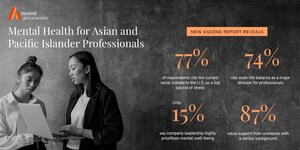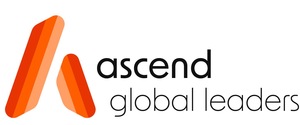Glass Ceiling for Asian Americans Is 3.7x Times Harder to Crack
Ascend Foundation publishes new research on Silicon Valley leadership diversity; Offers Executive Parity Index tool to measure the effect of race and gender
NEW YORK, May 6, 2015 /PRNewswire/ -- It's tough enough for women to crack the glass ceiling in business, but for Asian American men and women, the challenge is even greater. Released at the start of Asian-Pacific American Heritage Month, a new study from the Ascend® Foundation (www.ascendleadership.org) examines a problem that has been hidden in plain sight for decades and, for the first time, quantifies the impact of race and gender in a data-driven investigation of Silicon Valley's Asian glass ceiling.
The new report, Hidden in Plain Sight: Asian American Leaders in Silicon Valley (http://goo.gl/HeTLzs), analyzes the leadership pipeline using 2013 employment data filed with the U.S. Equal Employment Opportunity Commission (EEOC) by five major Silicon Valley-based companies — Google, Hewlett-Packard, Intel, LinkedIn, and Yahoo. Concurrently, Ascend, the largest non-profit Pan-Asian organization for business professionals in North America, has rolled out a new Executive Parity Index™ (EPI™) calculator tool on its website (www.ascendleadership.org/?page=EPI) that can be used by any company to help measure its leadership diversity.
Using a novel EPI approach to compare representation of South and East Asians in the leadership pipeline, the Ascend report uncovers surprising new insights about the role of race and gender in Silicon Valley:
- Although both race and gender are factors that contribute to a glass ceiling, the impact of race is 3.7 times more significant than the impact of gender as a negative factor for the Asian workforce within the companies examined.
- While white men are 42% more likely than white women to be an executive in these companies, they are 149% percent more likely than Asian men to be an executive, and 260% more likely than Asian women to be an executive.
- For Asian women in these companies, this translates into a "double whammy" race-plus-gender problem: Only 1 of every 285 Asian women is an executive, less than half the ratio for the entire workforce of 1 executive per 118 professionals.
"Most surprising is that the EEOC data has been widely reported, but no one bothered to look at its real implications," said Buck Gee, a former vice president and general manager at Cisco and one of the study co-authors. "With the EPI analysis approach, we now have a simple and meaningful way to measure and compare executive pipelines by gender and race."
A Wake-Up Call for Employers and Employees
"The common assumption is that Asians are successful since so many of them already work in Silicon Valley companies," said Janet Wong, a former partner at KPMG and study co-author. "However, our deeper EPI analysis reveals that while Asians are well-represented —even overrepresented— at the staff and professional levels, they are underrepresented in the management pipeline and barely seen at the executive levels."
This gap is a huge wake-up call for both employers and employees. "We believe this huge disparity is attributable to the clash between elements of traditional Asian culture and American corporate culture, specifically gaps in awareness, expectations, role models, and behavior," added Wong.
Denise Peck, a former vice president of marketing at Cisco and the third study author, stated, "While these gaps bring an important issue to the foreground, the good news is this is an addressable problem. The fastest and most effective way to build an Asian leadership pipeline is to attack the problem from both ends. Companies can conduct an affirmative search to identify high potential Asian managers and leverage culture-specific leadership programs, and Asian professionals must develop and demonstrate soft leadership skills. While many companies already realize that they have an Asian leadership gap, they can get a deeper understanding of their gender and racial gaps with an EPI analysis."
What's Your Company's EPI?
Many companies are unaware of the extent of their leadership pipeline problem, although every company with more than 100 employees is required to file an EEOC report. An easy way to determine whether your company has a leadership diversity imbalance hidden in plain sight is to plug the data from your most recent EEOC report into the EPI calculator on the Ascend website. Please also download a free copy of Hidden in Plain Sight: Asian American Leaders in Silicon Valley.
About Ascend Foundation and Ascend
Ascend Foundation is a 501(c)(3) organization with a mission to educate, advocate, and enable Pan-Asian business leaders to reach their full potential. Through its research and thought leadership activities, the Foundation's goal is to help Pan-Asian leaders make greater impacts in business.
Ascend (@AscendLeader) is the largest, non-profit Pan-Asian membership organization for business professionals in North America. Established in 2005, Ascend's network includes 60,000+ senior executives, professionals, and MBA/undergraduate students involved in its 40+ chapters. As a career lifecycle organization, it offers robust leadership and professional development programs designed to cultivate Pan-Asian talent by supporting its members in reaching their career potentials and by supporting its corporate partners to develop a strong, diverse, and inclusive workforce to achieve business growth. Visit www.ascendleadership.org for more information.
©2015 Ascend Foundation. Executive Parity Index and EPI are trademarks of Ascend Foundation. Other brand names may be trademarks of their respective owner(s). Information is subject to change without notice. All rights reserved.
Photo- http://photos.prnewswire.com/prnh/20150505/214050
SOURCE Ascend Foundation
Related Links
WANT YOUR COMPANY'S NEWS FEATURED ON PRNEWSWIRE.COM?
Newsrooms &
Influencers
Digital Media
Outlets
Journalists
Opted In






Share this article